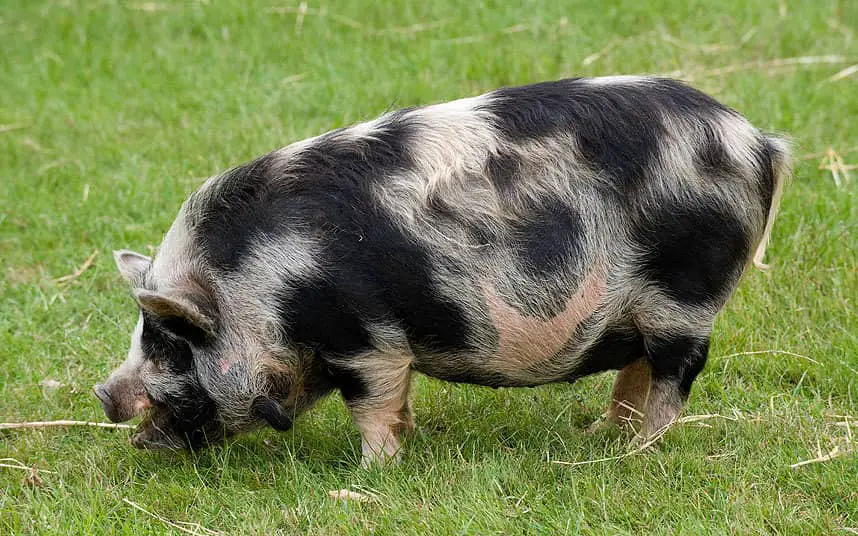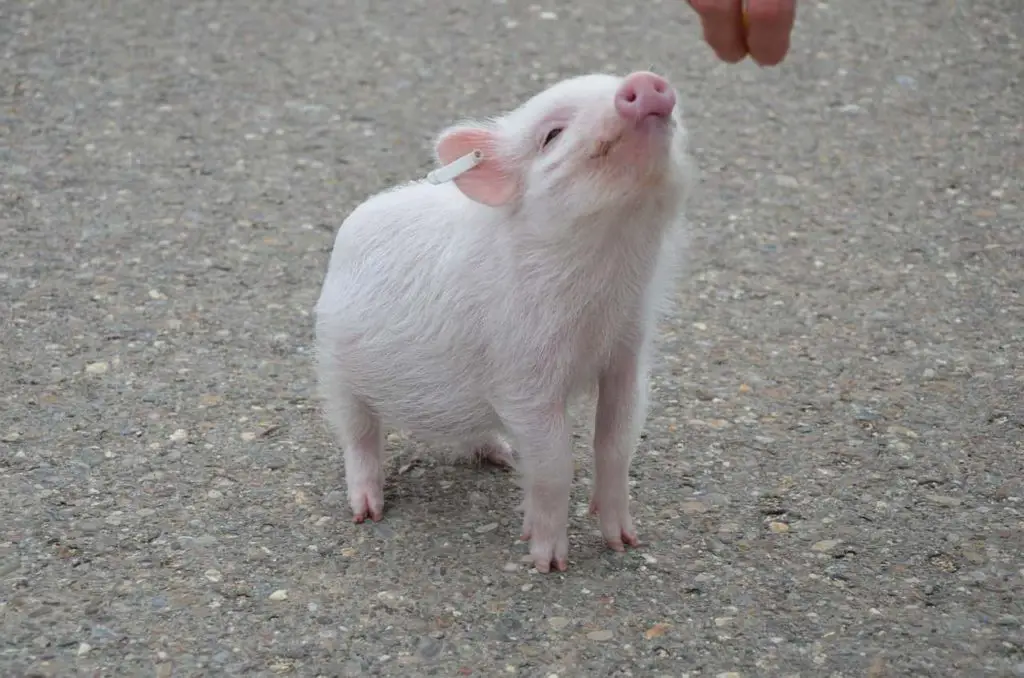Pigs are becoming more and more popular as house pets, so a lot of people are starting to wonder how hard it really is to take care of them.
How hard is it to take care of a pet pig? Pigs can be quite a challenge to take care of, especially if it’s your first time to take in a pet. But taking care of pigs can also be fun. The great news is, there are ways to prepare for these challenges so that your journey of taking care of a pet pig can get easier as you go along.
To prepare yourself in taking care of your new pet, you have to know a few basics about pigs first.

What to Feed Them
Pigs just love food! They’ll eat anything and everything. And since they have an amazing sense of smell, they’ll find any food you have around the house.
To take care of a pig’s nutritional needs, the common practice is to feed it half a cup per 25 lbs of its weight. So if you have a 75-lb pig, that means it needs a cup and a half of feeds per day. Just split that into two feedings and you’re all set.
Adult pigs would normally require a low-fat, low-protein, high-fiber diet. But that also depends on the kind of pig you have, as well as its overall health.
Nursing pigs, for example, would require more protein. Growing pigs would need more protein as well.
Aside from pig pellets, you can also give your pig treats in between feedings. These treats are usually given during training, as well as to reinforce good behavior. Just make sure you don’t give your pigs too much treats as this could also disturb the balance in their diet.
What treats can you give to your pig? Anything from Cheerios and popcorn, to apples and carrots are okay.
Just make sure you don’t overfeed your pig. This will make them overweight and can make them really sick.
One way to check if your pig is at optimal weight is checking for any fat rolling over your pig’s eyes. Avoid salty and fatty food as much as possible.
Don’t forget your pig’s water. They need easy access to drinking water at all times, especially during the hot seasons when they need to stay hydrated more than ever.
Providing Shelter
Now, let’s talk about giving your pig the kind of shelter it needs.
Unlike what you’ve probably believed your entire life, pigs are actually among the cleanest animals there are. So as early as now, be warned that you’re going to have to keep your pig’s living area nice and clean.
Choose their bedding well. Pigs are known to get allergies from some materials like hay, so it’s better to use straw instead.
Pigs actually love warm blankets, so that’s another option for you. Especially if you plan on keeping your pet pig inside your home, they would appreciate soft blankets that would keep them nice and comfy while they sleep or keep warm.
You also have to make sure that your pig enclosure is built to really keep them in even if you’re not watching. Because pigs are highly curious by nature, they will find ways to escape their pen the moment they find the smallest opportunity to do so.
They are also highly determined, so if they manage to escape once, know that they will try again and again. They will also get more creative in the way they plan their escape, so don’t underestimate them.

Keeping Them Entertained
Aside from being highly intelligent, pigs are also highly social creatures. They just hate getting bored! They yearn for mental stimulation most of the time.
The great news about keeping pigs entertained is that you don’t really have to get out of your way to do it. You can adjust the kind of activities you’ll have your pig participate in based on how much attention you can give them at a certain time.
Teaching them new tricks, for example, would be a great way to keep them entertained while satisfying their need for mental challenges. You can set aside 30 minutes to an hour each day to do this. Just make sure you keep that time consistent, because pigs love steady routines.
You can start with a few basic skills, like responding to commands like sit, stand, stay, or crawl. Give them a treat each time they do the trick right to reinforce that behavior.
As far as physical activities are concerned, there are a lot of materials you can use found around the house to keep them occupied. Kiddie pools, water and juice bottles, different kinds of fabrics, and kids’ toys are all acceptable, as long as they are bigger than your pig’s mouth and would not be a potential choking hazard.
For ideas on activities that would keep your pig entertained using everyday stuff you can find at home, here’s an article that discusses that.
Some quality time with your pig is also highly recommended. It’s not just for their entertainment, it’s also to keep them emotionally well.
Pigs just love belly rubs, as well as scratching behind their ears. You’d have to build momentum to do this though, especially if your pig still doesn’t trust you yet.
If your pig is just new around the home, you can start by running your hands over the pig’s head and talking to it in a gentle voice. Eventually, you’ll notice your pig warming up to you. Once you feel that your pig trusts you completely, you can become more affectionate to it.
Just make sure you don’t overdo it! Some pig owners make the mistake of treating their pigs like babies. Pigs don’t like being carried, for one. Never give your pig a slap on the rear end or on their shoulders, either. Even if you just mean it as a joke, your pig will become highly offended and it can easily become depressed because of this.
Neutering, Spaying, and Other Health Issues
If you’ve done a lot of pig research, then you’ve probably heard about the woes of failing to have your pig neutered or spayed.
Basically, pigs go through a huge change in disposition when they are “in heat”. And while they are usually amazingly clean pets (they hate it when their living area is dirty or smelly), all that cleanliness, good hygiene, and potty training goes out the window the moment they reach this stage.
This usually happens around the 3rd to 5th month, depending on the pig’s breed.
When a male pig is in heat, it goes around humping everything in its path. It also leaves around a trail of smelly substance from its penis. This makes it important to have them neutered before this happens.
A female pig, on the other hand, may exhibit signs of PMS. Female pigs may throw tantrums and exhibit grouchy behavior. They will pee all over the place as well, regardless if you’ve potty-trained them before. They should be spayed before they become a nuisance.
Aside from saving yourself from the tantrums of an unneutered or unspayed pig, you could potentially be saving them from the possibility of tumors and other similar illnesses common in pigs that are “unfixed”.
As for vaccinations, they are generally required for pigs that live around hogging areas since they are more prone to catch diseases from other pigs in the area. But if you want to stay on the safe side, you can consult your vet and find out which shots are applicable to your pig.

Tips in Caring for Your Pet Pig
- Set a routine.
One reason why some pig parents find it hard to take care of a pet pig is because they did not establish a routine. Without a proper routine, your pig would end up thinking that it can do anything any time it pleases.
Because of this, you’ll find yourself being disrupted from your usual routine.
As soon as you get your pet pig, set a proper time for eating, for playing, and for sleeping. This way, you have full control over what happens in your pig’s life (and in yours) most of the time.
- Start training them as early as possible.
Pigs are very intelligent and crave for mental stimulation. Their brains are also like sponges, especially when they’re still young. They can easily pick up new tricks and skills they are taught.
Although older pigs can still be taught a trick or two, they would already have established practices and routines of their own. This is why training should start as early as possible. After all, it’s easier for a pig to learn something new, as opposed to unlearning something they already know.
So what kind of training should you give your pig?
You can start out with some basic commands, like sit, stay, crawl, or shake hands. These are a great way to teach them how to behave well.
Since the importance of setting a routine has already been discussed, this is something that can also be taught while in training.
- Provide an exploratory environment.
Pigs are naturally curious and exploratory. After all, they are natural foragers. And when you don’t give them an environment that allows exploration, they would easily get bored and would become restless, and eventually, destructive.
Letting your pigs explore also keeps them healthy and happy.
Provide toys that would challenge your pig mentally. You can use dog puzzles as these would play the same role as it would for dogs.
You can also make your own toys for your pet pig. For example, you can use a water jug or juice bottle, poke some right-sized holes through them, then fill them up with oats or bits of other treats. You can have your pig roll them around the yard and get the treats inside to come out.
A kiddie pool would also be quite useful when you have a pig around. During the hot summer months, you can let vegetables float around and let your pig chase after them.
When the season gets colder, you can turn the pool into an indoor ball pit with treats and other toys mixed in with the balls.
- Set the right expectations.
One reason why people become overwhelmed with the task of taking care of a pet pig is because the wrong expectations were set.
For example, a lot of people think that just because they bought a “miniature” pig, they won’t get any bigger than they are now. But the truth is, even a teacup pig can reach around 300 lbs once it’s fully grown.
Find out everything you can find out about pigs. Don’t just blindly put your trust in what the pig seller says.
Know about their likes and dislikes, and find out more about their natural instincts. Knowing that they are natural foragers helps, as it also allows you to pig-proof your home (should you decide to keep it indoors). Know that it may potentially chew on your rugs, walls, and everything else it sees.
It’s also important to know what nutritional requirements your pig has. Find out about vaccinations and check how often you should be taking it to the vet.
- Keep them healthy physically, mentally, and emotionally.
You know what poses the biggest challenge when taking care of a pig?
An unhealthy pig.
When you plan your pig’s training, make sure you add not just mental exercises, but physical ones as well. It’s not true that pig’s are lazy! They love physical activities just as much as other house pets.
Always be on the lookout for signs that your pig is not comfortable or well. Any change in demeanor or appearance could tell you that something’s not right.
Be affectionate to them. Talk to them gently. Pigs are emotional, so you’ll want to make them feel good all the time.
When your pig is healthy, you have less to worry about, and your pig becomes much easier to take care of.
Related Questions
How long do pet pigs live?
When kept healthy and happy, pigs can live an average of 12 to 18 years. In fact, some pigs are able to live for up to 20 years! Wild pigs, on the other hand, are a different story altogether. Because they are exposed to the wild, they only live an average of 4 to 8 years.
How much should I feed my pet pig?
For non-breeding adult pigs, they should be fed half a cup of food for every 25 lbs of their weight. This means that a pig weighing 75 lbs should ideally be fed a cup and a half, split into 2 meals for the day. Pigs meant for breeding should be fed more, and would require more protein.
How big is a full-grown miniature pig?
Although considered miniature, a full-grown miniature pig can still weigh anywhere around 250 to 300 lbs. The term “miniature” is only used because compared to regular thoroughbreds that grow to 700 lbs or more, they are still considerably smaller.

